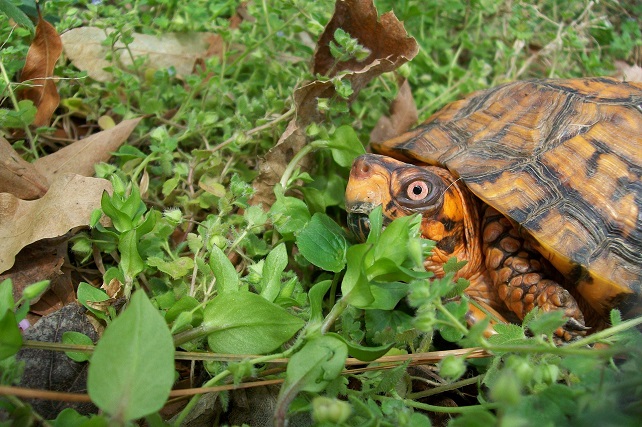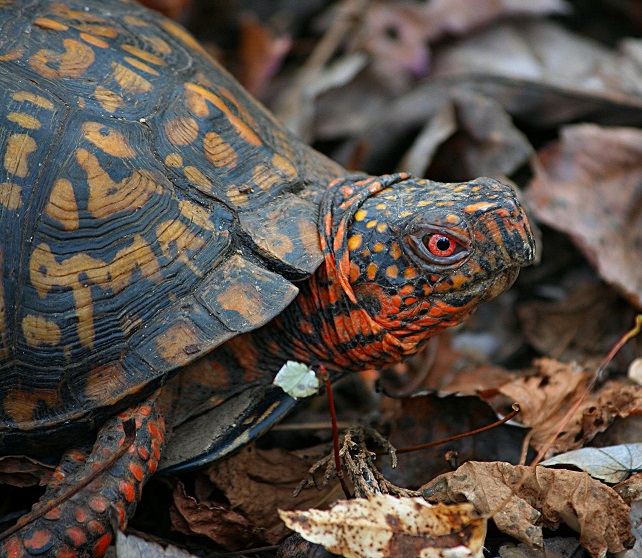World Turtle Day: The Eastern Box Turtle
For immediate release ‐ May 23, 2019
Contact: Jessica Wackes, 919.707.9850. Images available upon request
By Jess Wackes, PR & Marketing Coordinator
It’s World Turtle Day, a conservation-focused holiday that prompts us to come out of our shells (not sorry) as turtle lovers. Here at NCMNS, we’re thrilled to have the chance to highlight a species found here in North Carolina — the Eastern box turtle!
We’re in turtle awe!
These creatures are one of the most widely recognized turtle species in the Eastern US and one of only two species of box turtles in the country. Their tall, dome-shaped carapace — the upper part of the shell — is their most easily recognizable feature, colored in beautiful browns, yellows, and oranges. These earthy markings are excellent for camouflage among leaves and shadows on forest and grassy floors. Plus, these markings are unique to every turtle and can act as their “fingerprints” to identify specific turtles!
Despite their bold appearance, Eastern box turtles are small, growing from just over an inch to 6-7 inches in length over their long lives. The underside of the shell, the plastron, is hinged like a tiny door so that the turtle can pull its entire body inside and close up for protection. This excellent defense mechanism serves these turtles well throughout their average 25-35 year lifespans. Some have been known to survive to over 100 years old!

Eastern box turtles are forest dwellers and feed on a wide variety of plants, fungi, and small animals such as insects or slugs.
After it rains …
While these turtles typically live on land, you may sometimes see them enter shallow water to cool down on especially hot days or during periods of drought. They’re also very active after rain, and often, unfortunately, seen on roads after storms. These are extremely hazardous places for turtles just looking to cool down and refresh themselves, unknowingly at high risk of being struck by cars. In fact, death by car is one of the primary sources of Eastern box turtle mortality since they are well protected by their shells and have few natural predators.
As one of the slowest-growing and -reproducing turtle species, Eastern box turtles are sensitive to environmental changes and are the focus of several conservation efforts. In addition to deaths by cars, the turtles face ever-increasing habitat loss and fragmentation and have experienced a population decline as a result.

Eastern box turtles are forest dwellers and feed on a wide variety of plants, fungi, and small animals such as insects or slugs.
How can you help?
While the Eastern box turtle is one of the most widespread and readily recognizable turtle species, it is at risk of continued population decline and is in need of conservation efforts in some parts of its natural range.
The turtles are highly desirable pets, leading to the capture of wild turtles for sale in the pet industry. Avoiding purchase of these creatures stifles demand. If you have an Eastern box turtles that you no longer can care for, do not release them into the wild. They have a great homing instinct, so released pets will attempt to return to their natal grounds and encounter many dangers along the way. Instead, surrender them to local rescues, or re-home them to a new family.
If you see a box turtle in a dangerous place, like a street, and it’s safe for you to move them, please do! (Be sure to move them in their direction of travel.) Be the difference! The small actions we take to help the creatures around us help us create better futures for our world and the delicate ecosystems that surround us.
For more information about our upcoming activities, conservation news and ground-breaking research, follow @NaturalSciences on Instagram, Twitter and Facebook. Join the conversation with #visitNCMNS.

